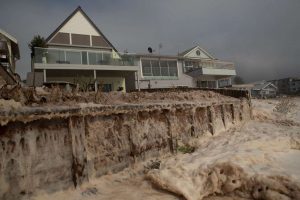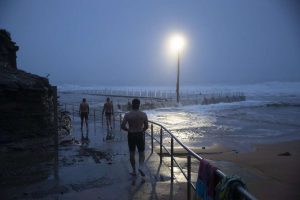FEBRUARY 10, 2020

SYDNEY, AUSTRALIA – FEBRUARY 10: Beach erosion is seen at Collaroy on the Northern Beaches as a high tide and large waves impact the coast on February 10, 2020 in Sydney, Australia. The Sydney area experienced its wettest weekend in more than 20 years, with strong winds and torrential rain causing flash flooding across the city. Evacuation orders remain in place for some parts of Sydney, while thousands of homes remain without power. The Bureau of Meteorology has forecast severe weather conditions again today with heavy rains, strong winds and damaging surf expected along NSW’s entire coast. (Photo by Brook Mitchell/Getty Images)
Torrential rains along Australia’s east coast caused widespread power outages and property damage at the weekend, and while the downpour has doused many wildfires there are now concerns that drinking water supplies will be contaminated by the flooding.
Sydney experienced its wettest 24 hours since 1992, with 176 millimeters (7 inches) of rain falling in the city between Sunday and Monday morning, according to the Bureau of Meteorology. And the wild weather is not over yet with another 200 millimeters expected in some areas by next weekend.
The deluge brought welcome inflows into dams in drought-stricken New South Wales state, with reservoirs now at about 64% capacity, up from 42% a week ago. About 206mm of rain fell in the Warragamba Dam catchment, which supplies the bulk of Sydney’s water, in the past week — about 38% of the total fall for the past year.
But there’s now concern that debris and ash from months of devastating wildfires is being swept into the water supply. The country is still grappling with the fallout from its worst fire season in generations, which saw more than 3,000 homes destroyed and claimed at least 31 lives.

More Sydney Storms Forecast Following Weekend Of Torrential Rain And Flooding. – Getty Images via Bloomberg
The water authority in NSW state said it is monitoring water quality to assess whether extra measures are needed to control ash and sediment. Water could be drawn from deeper in the dam or from elsewhere in the network if there were quality concerns.
The rains extinguished the massive Currowan Fire on the NSW south coast. The blaze had burnt for 74 days and destroyed 499,621 hectares of land, including 312 homes.
Drought Plans
The NSW government imposed level two water restrictions for Sydney in December and last year started planning to expand capacity at its desalination plant amid extended drought conditions, which had slashed water storage levels.
It’s unclear whether the weekend’s downpours will affect the restrictions or planning for the plant expansion. State water minister Melinda Pavey was not immediately available for comment.
Courtesy/Source: Bloomberg










































































































